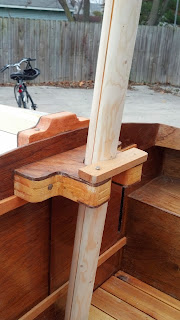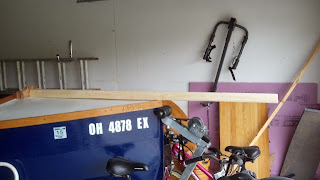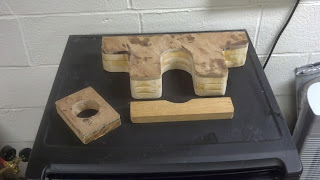The last thrilling experience sailing
Aerie on Lake Erie
ended with a cracked mast: the mainmast bent so much in strong winds that it
delaminated at a scarf joint four feet above the mast step.
I was faced with a choice among several not
too satisfactory options, all discussed with the good folks at the
Wooden Boat Forum.
The masts were too slender for
unstayed operation in strong wind.
I
could repair the mast and reinforce it with fiberglass tape at the joints, but
that would create stiffer parts that could lead to breaks elsewhere.
I could use a fiberglass sleeve (too
expensive and would lead to cracks down the line).
I could use a forestay and shrouds, which
would interfere with the turning of the yard and negate the simplicity of the
unstayed cat ketch rig.
I could build a
thicker, stronger mast, which would be hard to drop into its partner hole in
the foredeck.
I could replace the masts
with aluminum tubes, which would be expensive and require new tools and skills
such as pop-riveting.
Or re-rig the boat
completely.
I had already had many problems and confusions with rigging
the two masts: two each of halyards, snotters, downhauls and sheets that had to
be lying on the correct side and not fouling each other. So I thought, if I have to build a new mast,
why not be bold? In the end I decided to
switch to a gaff sloop rig, which will take a good amount of time to set up
before launch, but will be sturdy and less prone to confusion and mishap during
launch and sailing.

I went back to pencil and paper and designed the new rig to
be balanced, with only the slightest bit of weather helm.
Here’s the sketch, a bit messy but fine for my
purposes. Mainsail is about 80 square feet (7.2 square meters) and jib about half the size.
16 foot studs being a readily available size of lumber, I
settled on a 16-foot-long, 3-inch thick mast made from two studs glued
together. The bottom tapers to 2¼ inches
to fit into a mast step secured to the keel batten. The top has only a very slight taper since
the hounds are quite high up. Forestay
and shrouds will be 1/8-inch synthetic rope (amsteel blue, which is stronger
than steel and does not require expensive tools such as cutter and crimper) with
eye splices at both ends: the top ones loop around the mast through oak pad eyes,
the bottoms around steel thimbles, attached to steel turnbuckles. The turnbuckles attach to steel straps bolted
to the hull or bowsprit (everything is stainless of course).
The mast partner has a jaw-shaped slot for the mast, and
will be secured with bolts and glue to the main bulkhead. It is laminated from three layers of 1x8 pine
and one of 3/8-inch plywood. The mast
will be secured with an oak piece bolted through the partner.
A gaff sloop needs a jib, so I designed a 78-inch-long, 2¼
inch thick bowsprit laminated from three layers of 1x3 lumber. It has a slot that fits over the bow
extension which I had built in for just this eventuality. It will be secured to the bow extension with
a pin. Its aft end fits into a brace
bolted to the aft end of the foredeck.
The forestay will be attached to its forward tip, which is secured to
the lower bow with more line.
The mainsail is a classic gaff trapezoid, attached to an
8-foot gaff and an 11-foot boom. It will
have two sets of reef lines. Since my
original main mast came apart right near the 8-foot mark (second photo), I decided to cut it
to 8 feet and repurpose it as a gaff, with jaws made of oak and plywood and a
parrel line with plastic beads.
The mizzen mast, shortened only slightly, will serve as the
boom. I will be reusing a leftover
gooseneck I experimented with on my original boat. The boom will have a sheave at the clew end
for a clew outhaul, and will be controlled by a mainsheet with a 4:1 purchase
just aft of its middle.
The jib is a simple triangle and will be clipped onto the
forestay. The running rigging will
consist of three halyards (throat and peak for the gaff, and jib) and two
sheets (main and jib), plus a topping lift to assist with rigging and reefing. A total of seven blocks (three for halyards
and four for mainsheet), eight snap hooks and assorted cleats will be
needed. Most hardware will be repurposed
from the original rig; I only had to buy one block with a becket and two open
clam cleats. I decided that it is
important to have different-colored lines so inexperienced crew can be given
simple directions.
I have already bought most materials and hardware except for
some sailmaking supplies and line for the running rigging.
My new suppliers (and they are good and responsive) are
LFS Marine & Outdoor (good purveyors of amsteel rope and related hardware) and
Duckworks Boat Buiilders Supply (who stock parrel beads for gaff jaws, of all things, sailmaking supplies and good, inexpensive chandlery). The budget is about $350, or more if I run
out of epoxy.
Next I’ll be talking about adventures in boat carpentry, so keep rading 176inches.
boatbuilder

 The last photo shows the new mast and bowsprit. They still need some hardware and finishing, but I was pleasantly surprised at how straight a mast made from a couple of 2x4s turned out to be. It is a little awkward and definitely heavier than the previous ones (as it needs to be) but at least it does not need to be vertically dropped through a partner hole, something that would probably hurt my back at my age. I can shoulder it and walk it into place pretty easily.
The last photo shows the new mast and bowsprit. They still need some hardware and finishing, but I was pleasantly surprised at how straight a mast made from a couple of 2x4s turned out to be. It is a little awkward and definitely heavier than the previous ones (as it needs to be) but at least it does not need to be vertically dropped through a partner hole, something that would probably hurt my back at my age. I can shoulder it and walk it into place pretty easily.





